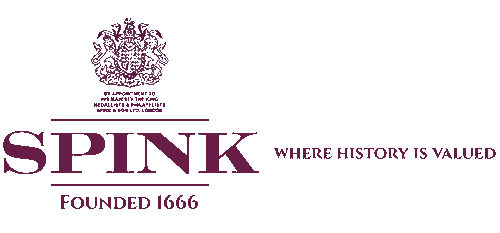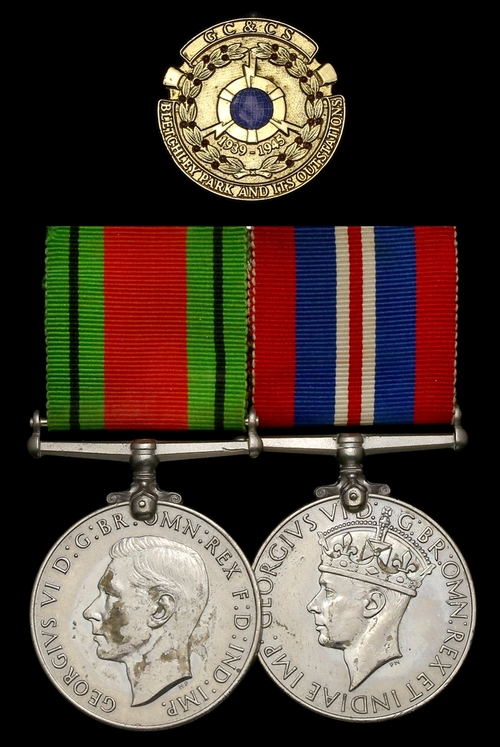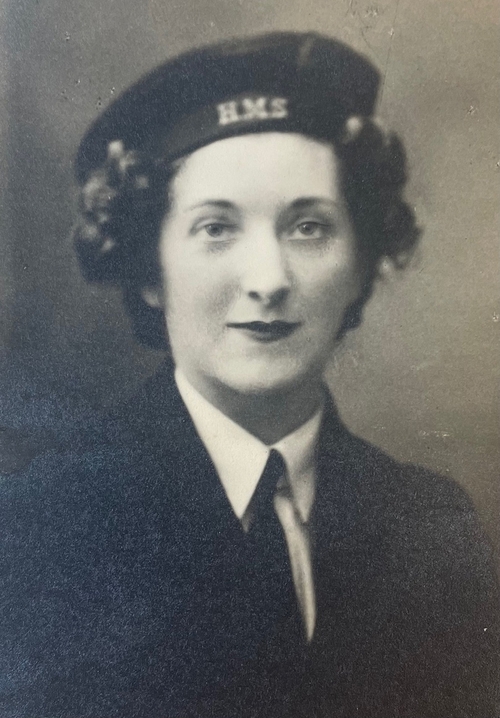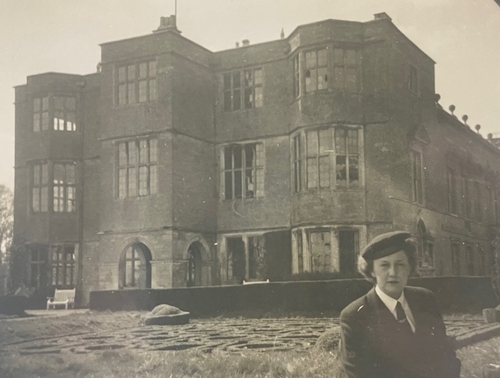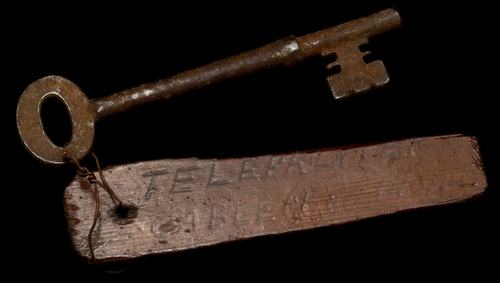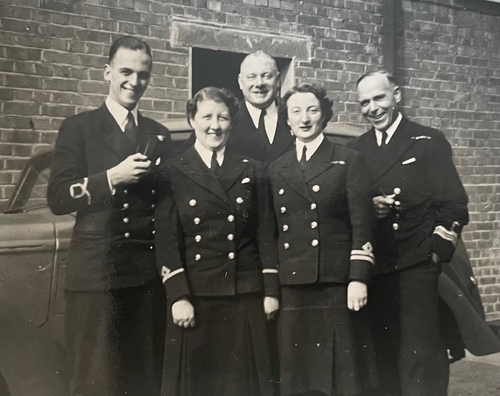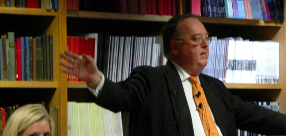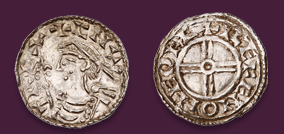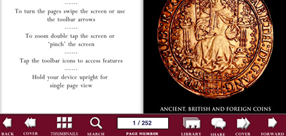Auction: 25003 - Orders, Decorations and Medals
Lot: 67
'Drafted to work at Bletchley Park with Alan Turing in the decoder room - which she called 'the bomb' - she only spoke openly about this in her later life. She remembered Alan Turing walking around the lake with his coffee in his hand, which he never got around to drinking and would throw it - cup and all - into the lake. Therefore, there should be plenty of cups in there!'
An accompanying handwritten statement refers, in respect of the memories of Josephine Lewington, W.R.N.S.
A rare Second World War Bletchley Park grouping to Josephine Lewington (née Hatter), Women's Royal Naval Service
As one of Churhill's 'geese who laid the Golden Eggs but never cackled', she served as a Bombe Operator at the outstations at Eastcote and Gayhurst and as an indexer at Bletchley itself
Defence and War Medals 1939-45, mounted as worn, good very fine (2)
Sold together with:
(i)
The official Government Code & Cipher School commemorative badge issued to ex-Bletchley Park personnel, gilt and enamel, obverse with central globe, with laurel wreath surround and the dates '1939-1945', and 'G.C. & C.S.' above, and 'Bletchley Park and Its Outstations' below, the reverse with embossed motto, 'We Also Serve', and brooch-pin fitting for wear.
(ii)
An ex-Bletchley Park steel key, with attached wooden identity label, upon which is etched 'Teleprinter Cable …. Side'.
(iii)
A Wren's wartime cap, by Sanders & Brightman, Luton, with linen chin strap, the inner band with ink inscription, 'E. A. K. Tatham', another Wren who served at Bletchley and who was presumably a friend of Hatter; together with a pair of embroidered uniform flashes.
(iv)
An album containing a fine array of wartime photographs (approx. 70), including scenes of Bletchley Park and related outstations, in addition to pictures of fellow Wrens, and an image of a mess dance at Bailleul Camp in May 1946, the reverse with several signatures.
(v)
A letter from the M.O.D. Medal Office at Innsworth, Gloucestershire, forwarding the recipient her 1939-45 Medal, dated 11 October 2006.
Josephine Minna Emile Lewington, née Hatter, served as a Bombe Operator at the Bletchley out stations at Eastcote (November 1943-January 1944) and Gayhurst Manor (January 1944-May 1945), when she was appointed an indexer and filer at Bletchley Park itself. She remained employed there until the year's end.
Someone who shared Lewington's Bombe duties was a fellow Wren, Torfrida Cox, née Boosey. She later wrote:
'Encrypted messages from German Enigma machines were transmitted in Morse. These transmissions were listened to at Bletchley and elsewhere, called Y Stations, when intercepted were sent by despatch rider or teleprinter to Hut 6 at Bletchley where the mathematician boffins produced what was called a menu. This menu was a diagram of settings for large electro-mechanical machines known as Bombes.
These Bombes, and there were hundreds of them, were the heart of the code breaking activity. Their purpose was, by trial and error, to find out what settings the Germans had used on their Enigma machines. Once we had that the German messages could be decoded.
A Bombe was a large rectangular box about 6ft, high and 3ft, deep, with rows of interchangeable coloured drums with lettering in front and wiring at the back which had to be plugged up as well as setting the drums. The whole thing was driven by an electrical motor with a sort of fan belt, which frequently wore out due to continuous use.
We W.R.N.S. worked the Bombes, I suppose it was like a factory, in three eight-hour watches night and day. We had 'music while you work' and the tea trolley came round at intervals, but as we were in artificial light this did cause some eye problems. Having set up the Bombe with the menu settings it was started up and chugged away, stopping when a possible match was found. The stop was then taken to the office for checking on a Typex machine, which had been modified to emulate an Enigma machine. If it turned out to be a match it went off in the decoding room.
Once the German Top Secret messages had been decoded by Bletchley they were known as ULTRA messages and were, of course, of the highest security and very limited distribution.
Security was absolutely vital and the whole operation trembled on a knife edge, for if the Germans had come to believe that their most important ciphers were being broken the disaster for the Allies would have been immeasurable.
As an example of ULTRA information on 23 October 1942, just before the Battle of Alamein started in North Africa, General Montgomery knew the strength and dispositions of the German army, notable shortages, morale, and the absence of its commander; for Rommel was in Germany unwell.
By the end of 1943 the wizards of Bletchley had devised another bigger and better monster called COLOSSUS, which being almost wholly electronic, was accurate and could produce results quickly and precisely. Once the correct key had been found it could decipher all further traffic in that key. Later, COLOSSUS Mark II was invented, and this could be said to have been the very first computer. It was ordered in February 1944 and went into action on 1st June 1944 just in time for D Day-a tremendous achievement.
Thereafter the Bombes and Colossi continued to clatter and hum away until VE Day when they all fell silent for the first time in four years… On our return from VE Day celebration leave, we all sat down with screwdrivers and destroyed all the drums. The Bombes were also dismantled and disappeared but Colossus, with the new technology it had pioneered, was pressed into further use in different ways but, sadly, when computers began being developed openly everywhere, the originals disappeared without trace. It is only now that Bletchley Park is being preserved as a Museum that efforts are being made to rebuild COLOSSUS and, I believe, a Bombe.'
Note
Elisabeth Alison Kempley Marshall, née Tatham, served in the Naval Section, NS V Japanese, indexing Japanese ship locations, from November 1944 to October 1945. It's not without interest that Josephine Lewington was employed as an indexer at Bletchley Park in the same period, and given the inclusion of Tatham's W.R.N.S. cap, it seems probable they were friends. Or, of course, it was obtained by reason of a cloak room mix-up.
Either way, it's a rare wartime survivor with direct links to Bletchley Park, perhaps even a witness to Alan Turing tossing another coffee cup into the lake?
Subject to 20% VAT on Buyer’s Premium. For more information please view Terms and Conditions for Buyers.
Estimate
£500 to £700
Starting price
£400
